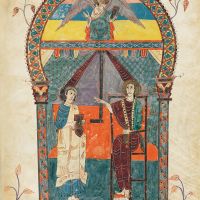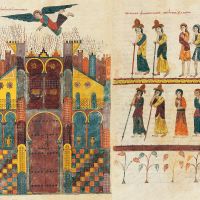The Girona Beatus, with its extraordinary and complex iconographical variety, was the crowning achievement of the works produced by the San Salvador de Tábara scriptorium.
The elements amassed from different backgrounds, particularly those of classical Carolingian and Muslim origin, and the almost completely original new subject matter incorporated for the first time, make one wonder how all this was possible in Tabara monastery in 975. What library endowed with illuminated manuscripts did the artists have access to? It must also be said that without the artists’ imagination and their ability to use, manipulate and transform the material received – something we often and almost always rightly deny them – the outcome would have been very different.
What makes this manuscript unique is the vast number of additional illustrations it contains in comparison to previous Beatus. It begins with a Cross and a Maiestas, followed by a vision of heaven having no known, extant precedents, and continues with six miniatures of the Evangelists. It also features genealogies which extend throughout a remarkable cycle of the life and death of Jesus Christ, a cycle found in no other codex and rather uncommon in the art of that period on mainland Spain
“A few years after the completion of the Valcavado Beatus, work began on one of the most important and lavishly illustrated, extant Spanish manuscripts of all time: the Gerona Beatus – further proof that a beatus codex is far more than merely an illuminated commentary on the Apocalypse by an abbot from Liébana called Beatus (...). Along with the Facundus Beatus it is also one of the best-known manuscripts and, almost certainly, the one studied most often. It is also the largest codex prior to the advent of the last large manuscripts of the 12th and 13th centuries (the Cardeña, Arroyo and Las Huelgas beatus manuscripts), despite having been trimmed when rebound. Although this work contains more Muslim elements than any other, it also features countless signs of Carolingian origin. Finally, its wealth of illustrations of subjects other than the Apocalypse implies certain knowledge of some rather unusual texts, as reflected in the rather unusual images accompanying them.”
Joaquín Yarza
Beato de Liébana. Manuscritos iluminados





















































